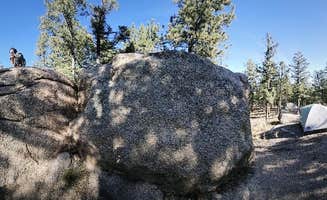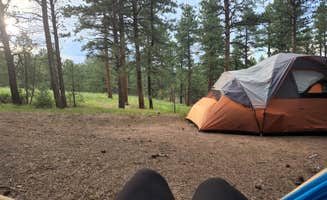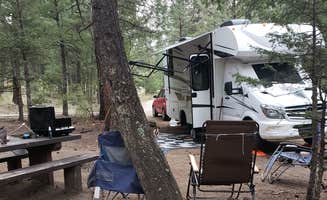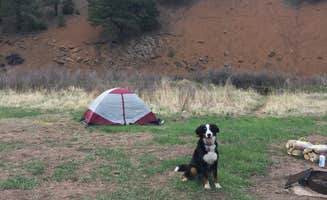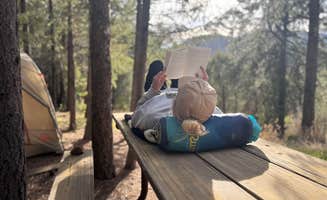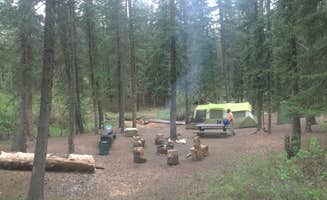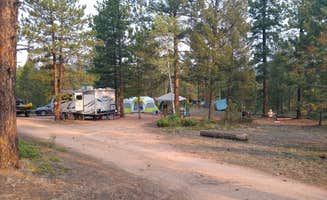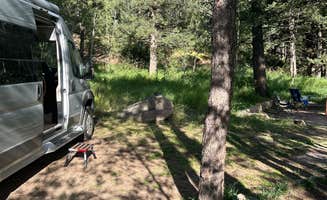Buffalo Creek, Colorado sits at approximately 7,400 feet elevation within Pike National Forest, about 45 miles southwest of Denver. The camping areas near Buffalo Creek feature ponderosa pine forests, with dramatic rock formations created by ancient geological activity. Summer daytime temperatures typically range from 70-85°F but can drop to 40-50°F at night, making layered clothing essential for comfort.
What to do
Mountain biking trails: Access one of Colorado's premier trail systems. The Buffalo Creek Recreation Area offers extensive mountain biking opportunities with varied difficulty levels. "Great place to spend a day to a few weeks depending on lifestyle. Fire pits and hiking near," notes one visitor. The interconnected trail network provides options for riders of all abilities.
Fishing spots: Try your luck in nearby streams and lakes. Several fishing locations exist within short driving distance. As one camper at Osprey Campground reports, "We were in the area to fish as much of the river as possible and this was a great site." The South Platte River flows through the region, offering catch-and-release trout fishing opportunities.
Hiking access: Connect directly to the Colorado Trail. Several campgrounds provide direct access to major hiking routes. A visitor at Buffalo Campground mentioned, "Welcoming campground, spur trails connecting it straight to the Colorado Trail and other connections in the Buffalo Creek Recreation Area." Many trails pass through areas recovering from the 1996 wildfire, providing educational opportunities about forest regeneration.
What campers like
Spacious sites: Enjoy room to spread out. Many campers appreciate the generous site sizes at camping areas near Buffalo Creek. According to a review of Redskin Creek Rd Dispersed Campsite, "Sites are spaced well apart, some sites are covered in trees while others are wide open." These dispersed sites allow for more privacy than typical established campgrounds.
Water access: Cool off during summer months. Some campsites offer direct water access. At Lone Rock Campground, "Really cool campground! We were able to tube on the river and we were at site five so we had direct access to the river as well." These water-adjacent sites provide relief during hot summer days.
Quiet weekday camping: Avoid weekend crowds. Many campers recommend visiting mid-week when possible. A review of Rampart Range Recreation Area states, "We arrived Wednesday morning and realized it was too far in than we would've liked so we landed at site 33 and it was AMAZING! No trail directly near the site, no sites surrounding." Mid-week arrivals significantly improve your chances of finding preferred sites.
What you should know
Fire restrictions: Check current regulations before arrival. Fire bans frequently affect this area, especially during dry summer months. "Currently they don't have day-use open, so there's plenty of space at the lake to set-up and spend the day playing with the kids," noted a visitor at Castle Mountain Recreation Area at Wellington Lake. Always check with the Pike National Forest website or ranger station before your trip.
Weather preparedness: Expect significant temperature swings. The mountain location means dramatic temperature changes between day and night. A camper advised, "Denver's weather will not tell you what the weather here will be and most forecasts are inaccurate. It will be at least 20 degrees colder at night than Denver most likely." Pack accordingly with warm layers even for summer camping.
Limited services: Bring essential supplies. Most camping areas have no water sources. "There are water spigots but according to the camp hosts the Government didn't approve for them to be turned on this year," reported one camper. Cell service is also extremely limited throughout the area, so download maps and information before arrival.
Tips for camping with families
Site selection: Arrive early for lake-adjacent sites. Families with children often prefer spots near water features. "We found a great spot to fit our 29' camper plus truck well. Overall great camping trip. Bathrooms were clean, camp host was friendly and also made sure people were safe and following the rules," shared a family that visited Buffalo Campground.
Wildlife awareness: Teach proper food storage practices. Bears are active in this region. "There are black bears in the area, I heard one rummaging around the trash bin around 4AM... make sure you don't keep food in your tent and throw away your trash each night so they don't visit your site." Hard-sided food storage containers are recommended.
Activity timing: Plan around afternoon storms. Summer thunderstorms frequently develop by early afternoon. "Midday storms are pretty common but the mornings and evenings are oh so beautiful," one camper observed. Schedule hiking and outdoor activities for mornings when possible to avoid lightning risk.
Tips for RVers
Road conditions: Access varies by location. Most dispersed sites have unimproved access roads. A reviewer noted, "The road is a bit of a washboard, but that is nothing compared to most of the forest roads in Colorado." Many sites can accommodate smaller to medium-sized RVs, but larger rigs should stick to established campgrounds.
Site leveling: Bring extra blocks and levelers. Many sites feature uneven terrain. "The parking areas tend to be very unlevel and there are only a few that you can pull right up to your campsite," observed one RVer. Scout potential sites before committing, as backing out can be difficult on narrow forest roads.
Generator use: Check regulations and be considerate. Most areas have specific quiet hours and generator use restrictions. Prepare for dry camping with limited or no hookups, and consider alternative power sources like solar that won't disturb neighbors in these peaceful settings.


